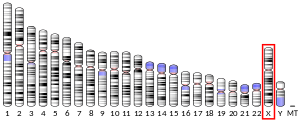DDX53
DEAD-box helicase 53 is a protein that in humans is encoded by the DDX53 gene. [3]
| DDX53 | |||||||||||||||||||||||||
|---|---|---|---|---|---|---|---|---|---|---|---|---|---|---|---|---|---|---|---|---|---|---|---|---|---|
| |||||||||||||||||||||||||
| Identifiers | |||||||||||||||||||||||||
| Aliases | DDX53, CAGE, CT26, DEAD-box helicase 53 | ||||||||||||||||||||||||
| External IDs | HomoloGene: 85175 GeneCards: DDX53 | ||||||||||||||||||||||||
| |||||||||||||||||||||||||
| |||||||||||||||||||||||||
| Orthologs | |||||||||||||||||||||||||
| Species | Human | Mouse | |||||||||||||||||||||||
| Entrez |
| ||||||||||||||||||||||||
| Ensembl |
| ||||||||||||||||||||||||
| UniProt |
| ||||||||||||||||||||||||
| RefSeq (mRNA) |
| ||||||||||||||||||||||||
| RefSeq (protein) |
| ||||||||||||||||||||||||
| Location (UCSC) | Chr X: 23 – 23 Mb | n/a | |||||||||||||||||||||||
| PubMed search | [2] | n/a | |||||||||||||||||||||||
| Wikidata | |||||||||||||||||||||||||
| |||||||||||||||||||||||||
Function
This intronless gene encodes a protein which contains several domains found in members of the DEAD-box helicase protein family. Other members of this protein family participate in ATP-dependent RNA unwinding.
gollark: Since what I don't actually know.
gollark: It says 4 million added lines.
gollark: Hold on, I'll load the latest data from their community metrics thing.
gollark: <@!330678593904443393> MediaWiki is about 20 times larger still?
gollark: My server is less responsive than usual even *after* I shut down the osmarks.net search engine rampantly consuming all resources.
References
- GRCh38: Ensembl release 89: ENSG00000184735 - Ensembl, May 2017
- "Human PubMed Reference:". National Center for Biotechnology Information, U.S. National Library of Medicine.
- "Entrez Gene: DEAD-box helicase 53". Retrieved 2017-08-18.
Further reading
- Cho B, Lim Y, Lee DY, Park SY, Lee H, Kim WH, Yang H, Bang YJ, Jeoung DI (2002). "Identification and characterization of a novel cancer/testis antigen gene CAGE". Biochem. Biophys. Res. Commun. 292 (3): 715–26. doi:10.1006/bbrc.2002.6701. PMID 11922625.
- Cho B, Lee H, Jeong S, Bang YJ, Lee HJ, Hwang KS, Kim HY, Lee YS, Kang GH, Jeoung DI (2003). "Promoter hypomethylation of a novel cancer/testis antigen gene CAGE is correlated with its aberrant expression and is seen in premalignant stage of gastric carcinoma". Biochem. Biophys. Res. Commun. 307 (1): 52–63. doi:10.1016/s0006-291x(03)01121-5. PMID 12849980.
- Shim H, Lee H, Jeoung D (2006). "Cancer/testis antigen cancer-associated gene (CAGE) promotes motility of cancer cells through activation of focal adhesion kinase (FAK)". Biotechnol. Lett. 28 (24): 2057–63. doi:10.1007/s10529-006-9190-8. PMID 17028776.
- Lee TS, Kim JW, Kang GH, Park NH, Song YS, Kang SB, Lee HP (2006). "DNA hypomethylation of CAGE promotors in squamous cell carcinoma of uterine cervix". Ann. N. Y. Acad. Sci. 1091: 218–24. doi:10.1196/annals.1378.068. PMID 17341616.
- Kim Y, Jeoung D (2008). "Role of CAGE, a novel cancer/testis antigen, in various cellular processes, including tumorigenesis, cytolytic T lymphocyte induction, and cell motility". J. Microbiol. Biotechnol. 18 (3): 600–10. PMID 18388483.
- Pinto D, Pagnamenta AT, Klei L, Anney R, Merico D, Regan R, Conroy J, Magalhaes TR, Correia C, Abrahams BS, Almeida J, Bacchelli E, Bader GD, Bailey AJ, Baird G, Battaglia A, Berney T, Bolshakova N, Bölte S, Bolton PF, Bourgeron T, Brennan S, Brian J, Bryson SE, Carson AR, Casallo G, Casey J, Chung BH, Cochrane L, Corsello C, Crawford EL, Crossett A, Cytrynbaum C, Dawson G, de Jonge M, Delorme R, Drmic I, Duketis E, Duque F, Estes A, Farrar P, Fernandez BA, Folstein SE, Fombonne E, Freitag CM, Gilbert J, Gillberg C, Glessner JT, Goldberg J, Green A, Green J, Guter SJ, Hakonarson H, Heron EA, Hill M, Holt R, Howe JL, Hughes G, Hus V, Igliozzi R, Kim C, Klauck SM, Kolevzon A, Korvatska O, Kustanovich V, Lajonchere CM, Lamb JA, Laskawiec M, Leboyer M, Le Couteur A, Leventhal BL, Lionel AC, Liu XQ, Lord C, Lotspeich L, Lund SC, Maestrini E, Mahoney W, Mantoulan C, Marshall CR, McConachie H, McDougle CJ, McGrath J, McMahon WM, Merikangas A, Migita O, Minshew NJ, Mirza GK, Munson J, Nelson SF, Noakes C, Noor A, Nygren G, Oliveira G, Papanikolaou K, Parr JR, Parrini B, Paton T, Pickles A, Pilorge M, Piven J, Ponting CP, Posey DJ, Poustka A, Poustka F, Prasad A, Ragoussis J, Renshaw K, Rickaby J, Roberts W, Roeder K, Roge B, Rutter ML, Bierut LJ, Rice JP, Salt J, Sansom K, Sato D, Segurado R, Sequeira AF, Senman L, Shah N, Sheffield VC, Soorya L, Sousa I, Stein O, Sykes N, Stoppioni V, Strawbridge C, Tancredi R, Tansey K, Thiruvahindrapduram B, Thompson AP, Thomson S, Tryfon A, Tsiantis J, Van Engeland H, Vincent JB, Volkmar F, Wallace S, Wang K, Wang Z, Wassink TH, Webber C, Weksberg R, Wing K, Wittemeyer K, Wood S, Wu J, Yaspan BL, Zurawiecki D, Zwaigenbaum L, Buxbaum JD, Cantor RM, Cook EH, Coon H, Cuccaro ML, Devlin B, Ennis S, Gallagher L, Geschwind DH, Gill M, Haines JL, Hallmayer J, Miller J, Monaco AP, Nurnberger JI, Paterson AD, Pericak-Vance MA, Schellenberg GD, Szatmari P, Vicente AM, Vieland VJ, Wijsman EM, Scherer SW, Sutcliffe JS, Betancur C (2010). "Functional impact of global rare copy number variation in autism spectrum disorders". Nature. 466 (7304): 368–72. doi:10.1038/nature09146. PMC 3021798. PMID 20531469.
- Kim Y, Park H, Park D, Lee YS, Choe J, Hahn JH, Lee H, Kim YM, Jeoung D (2010). "Cancer/testis antigen CAGE exerts negative regulation on p53 expression through HDAC2 and confers resistance to anti-cancer drugs". J. Biol. Chem. 285 (34): 25957–68. doi:10.1074/jbc.M109.095950. PMC 2923988. PMID 20534591.
- Kim Y, Kim H, Park D, Han M, Lee H, Lee YS, Choe J, Kim YM, Jeoung D (2016). "miR-217 and CAGE form feedback loop and regulates the response to anti-cancer drugs through EGFR and HER2". Oncotarget. 7 (9): 10297–321. doi:10.18632/oncotarget.7185. PMC 4891121. PMID 26863629.
- Kim H, Kim Y, Goh H, Jeoung D (2016). "Histone Deacetylase-3/CAGE Axis Targets EGFR Signaling and Regulates the Response to Anti-Cancer Drugs". Mol. Cells. 39 (3): 229–41. doi:10.14348/molcells.2016.2244. PMC 4794605. PMID 26883907.
This article incorporates text from the United States National Library of Medicine, which is in the public domain.
This article is issued from Wikipedia. The text is licensed under Creative Commons - Attribution - Sharealike. Additional terms may apply for the media files.

